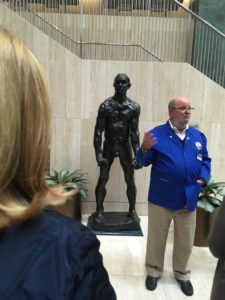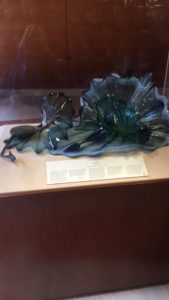I took the Mayo Clinic art tour yesterday. Yes, you’ve read that right. It turns out that in addition to their renowned coordinated medical care, the Rochester, MN clinic’s buildings are home to an impressive collection of paintings, sculptures, and glasswork rivaling many museums. According to the pamphlet accompanying the tour, “Mayo Clinic has always believed that restoring the mind and spirit is an important part of making the body well — and that art and science together play a role in the healing process.” Over the years, benefactors have supplied a collection that includes the Auguste Rodin piece Jean d’Aire, a Flowers series by Andy Warhol, a massive glass sculpture collection spread throughout the Gonda Building featuring works by Dale Chihuly, and many more artists who I would name-drop if I were cultured enough to know which ones to name-drop. Some of the contributing artists or benefactors were treated at Mayo or have family members who were.


The Plummer Building, Mayo’s oldest building still in use today (dedicated 1928), is basically a work of art itself (I thought that was just my original thought but the pamphlet says “the Romanesque-style building is a work of art in itself, both inside and out”). It’s fifteen stories high, topped with a bell tower complete with a fully functional carillon and surrounding balcony. The exterior of this tower is adorned by stone gargoyles, griffins and, as I learned on the tour, busts of women meant to honor the nursing staff. The interior of the Plummer Building just screams, “We have no idea the global economy is going to crash next year.” Take a look:

But the piece that gave me and most tour-goers pause was a kinetic piece by Israeli sculptor Yaacov Agam, simply called Welcome. Agam’s son was treated for a heart condition at Mayo in 1975. The tour guide quoted Agam on the tour, and I later found the quote here: Agam meant for the piece to help patients and their families “rise out of the gray of individual worry and respond to life’s ever-changing rainbow of possibility.” A YouTube posting of the sculpture is unfortunately way sped up; I encourage you to watch my 2-minute real-time video of the slowly rotating solid below for the intended effect. My comments will come after so you can form your impressions first.
If a picture is worth a thousand words, then there’s a thousand words for each of the infinitely many iterations this piece begets. So let us talk about the change itself, a process through which Agam makes us sure we’re seeing one thing, then nudges us through the medium of time until we are definitely seeing something completely different, but can’t quite recall how we got from A to B. The timing is gentle enough to give the illusion that we can somehow comprehend the mystery, track it clinically and incrementally; and yet the sum of these small changes creeps up on us, and forces us to reevaluate. We must adjust to a new paradigm that – despite being the result of every small change previous to it – makes itself appear sudden. And yet every attempt at adjusting will again be slowly swept away as the picture changes. Sometimes the picture is incoherent, too busy, too many moving parts. And sometimes the coherent picture can only be seen on a panel that is fading from view.
Watching the piece in person, I felt something awaken in me at the cellular level. My medical problems have of late taken on the labile, ever-changing quality of Welcome. The diagnosis I received at Mayo this week – mast cell activation disorder (MCAD or MCAS) – describes one of the more chaotic and bizarre conditions a doctor might see in his practice. Dr. Lawrence Afrin, one of the pioneering researchers of the condition, writes in his diagnostic guide that “the general presenting motif of MCAS is chronic multisystem polymorbidity, generally of an inflammatory theme and with assorted elements waxing and waning over time, sometimes in synchronization with one another but more often cycling with different periods and amplitudes.” Or in English – the symptoms can happen in any body system – eyes, ears, mouth, lymphatic, pulmonary, cardiovascular, gastrointestinal, genitourinary, musculoskeletal, neurologic, psychiatric, metabolic, hematologic, or immunologic – and they all can wax and wane, independently or not, with no discernible pattern.
I have known the “gray of individual worry” of which Agam speaks. Long-term illness drills some fear-driven habits into you that are sometimes necessary when you are very ill, but become maladaptive as soon as the situation changes. Illness trains you to label and analyze everything your body does, to become a bloodhound for potential upset or danger. No longer can you let a stomachache just be a stomachache; it’s a sign, or a data point, or a harbinger – something requiring action and documentation. But with something like MCAS, where symptoms can not only appear seemingly at random but also go away just as quickly, how much use is it for my life to get bogged down in the details?
At the same time, it feels hollow to say that when my careful documentation of these symptoms is what allowed me to obtain a diagnosis in the first place. But what I need to work on more is my stifling habit of judging and labeling these symptoms, the now-reflexive projection into the future of “Because I have a headache now, I can’t go to the party that is in four hours,” or “Because I’ve had severe mood swings for two days [something that happened earlier this week], I will feel this terrible forever and won’t be able to write a blog.” This tendency is a relic of a time when my health required so much management that it was often safer and smarter to preemptively say no to everything. But at this time in my life, the answer to change is not immediate judgment but observation and adaptation to rapidly shifting realities. It is time to shed the “gray of individual worry” and step into that “ever-changing rainbow of possibility.” What exactly that will mean remains to be seen. I leave you with the double rainbow that touched down over my AirBnB when I got to Rochester:

